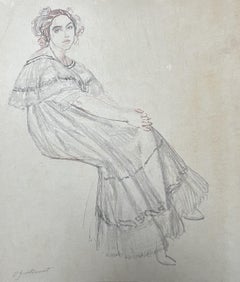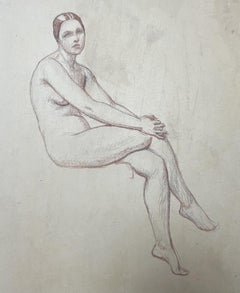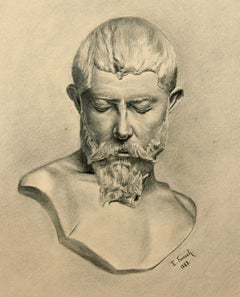Octave Guillonnet Drawings and Watercolor Paintings
to
2
Overall Width
to
Overall Height
to
2
2
2
2
2
2
2
1
1
2
2
4
932
406
282
279
2
2
Artist: Octave Guillonnet
Octave Denis Victor Guillonnet (1872 - 1967) A woman seated, drawing signed
By Octave Guillonnet
Located in Paris, FR
Octave Denis Victor Guillonnet (1872 - 1967)
A young woman seated
signed lower leftt
Charcoal, red and white chalks on thin paper transfered on cardboard
49 x 39 cm
Framed : 55.5 x ...
Category
1930s Art Deco Octave Guillonnet Drawings and Watercolor Paintings
Materials
Chalk, Charcoal
Octave Denis Victor Guillonnet (1872 - 1967) A naked woman seated, drawing
By Octave Guillonnet
Located in Paris, FR
Octave Denis Victor Guillonnet (1872 - 1967)
A naked young woman seated
Charcoal and red chalk on thin paper transfered on cardboard
49 x 39 cm
Framed : 55.5 x 45.5 cm
Octave Denis...
Category
1930s Art Deco Octave Guillonnet Drawings and Watercolor Paintings
Materials
Chalk, Charcoal
Related Items
Sketch of a head - Carved in stone -
Located in Berlin, DE
Emil Faesch (1865 Basel - 1915 Basel). Sketch of a head. Charcoal on painting cardboard, 60 x 47.5 cm (folio size), signed and dated at lower right "E. Faesch. 1888.".
Minor browning.
- Carved in stone -
About the artwork
The life-size head has an immensely present presence. This effect is due to the fact that Faesch took his cue from academic classical...
Category
1880s Realist Octave Guillonnet Drawings and Watercolor Paintings
Materials
Chalk
$433 Sale Price
20% Off
H 23.63 in W 18.9 in D 0.4 in
Untitled (Man Reclining on Tile Floor)
By Mark Beard
Located in New York, NY
Graphite and conté crayon on paper
Signed and dated, l.r.
This artwork is offered by ClampArt, located in New York City.
Mark Beard, born in 1956 in Salt Lake City, now lives in Ne...
Category
1970s Realist Octave Guillonnet Drawings and Watercolor Paintings
Materials
Paper, Graphite, Conté
The Loving Couple
By Charles Angrand
Located in Paris, Île-de-France
Circle of Charles Angrand (1854-1926)
The Loving Couple
Pencil and stump on paper,
30 x 22 cm
Dated "10.4.19" lower left. Trace of a dedication
Otherwise unsigned.
Provenance:
Pr...
Category
1910s Post-Impressionist Octave Guillonnet Drawings and Watercolor Paintings
Materials
Conté, Carbon Pencil
Dancing Couple
Located in Paris, Île-de-France
Attributed to Charles-Nicolas Cochin the Younger (Paris, 1715 – 1790)
Dancing Couple
Circa 1765–1770
Red chalk on cream paper; verso in black and red chalk
34 × 21 cm
Unsigned
Pro...
Category
Late 18th Century Old Masters Octave Guillonnet Drawings and Watercolor Paintings
Materials
Chalk
Portrait of a Man’s Head
By William Etty
Located in London, GB
Charcoal and white chalk highlight on paper
Label of J.M Maas Gallery (verso)
36cm × 28cm (54cm × 43cm framed)
Etty, a student of Thomas Lawrence, R.A., was the first significant Br...
Category
19th Century English School Octave Guillonnet Drawings and Watercolor Paintings
Materials
Paper, Chalk, Charcoal
Studies of a kneeling female figure, an arm, a hand, and a head in profile
By Carlo Maratta (Ancona 1625 - Rome 1713)
Located in Paris, Île-de-France
Studio of Carlo Maratti (or Maratta)
Camerano 1625 – Rome 1713
Studies of a kneeling female figure, an arm, a hand, and a head in profile
Red chalk on paper
43.4 x 26.6 cm
Unsigne...
Category
Late 17th Century Old Masters Octave Guillonnet Drawings and Watercolor Paintings
Materials
Chalk
$10,241
H 17.09 in W 10.48 in
Persephone, 19th Century Classical French Academy Drawing, Chalk and Pencil.
Located in Cotignac, FR
19th Century French Academy drawing of a classical maiden, signed Xavier Rendeley bottom right, numbered and dated 2nd April 1883. Presented in ...
Category
1880s Octave Guillonnet Drawings and Watercolor Paintings
Materials
Paper, Chalk, Pencil
$819
H 23.5 in W 19.5 in D 1 in
Half-length portrait of a Pharisee - In the shadow of betrayal -
Located in Berlin, DE
Hermann Prell (1854 Leipzig - 1922 Dresden-Loschwitz). Half-length portrait of a Pharisee, 1885. Sketch for the right-hand figure in the painting Judas Iscariot, 1886. Pencil drawing heightened with opaque white and black chalk on beige-grey wove paper (papier vélin), 34 x 27.8 cm (visible size), 52 x 45 cm (mount), signed, dated and inscribed "H. PRELL 1885 zu 'Judas'".
Minor browning, collection stamp on the reverse.
- In the shadow of betrayal -
About the artwork
This painting is the sketch for the head of the Pharisee offering the coins to Judas in one of Herrmann Prell's major works, the painting Betrayal of Judas, completed in 1886. The painting belongs to the Staatliche Kunstsammlungen Dresden and is illustrated in Adolf Rosenberg: Prell, Bielefeld and Leipzig 1901, p. 21 (Fig. 19). It is especially highlighted in Thieme-Becker (vol. 27, p. 376).
Hermann Prell, Betrayal of Judas, 1886
The monumental head, which fills the picture and is distinguished by its ornamented robe, is almost a lost profile, which in the executed painting is justified by the Pharisee's turning towards Judas. Despite the fact that the sitter withdraws from the viewer by turning away, it was necessary to artistically elaborate the motivation for the purchase of one of Christ's disciples, which is why the drawing focuses on the expression of the face, while the 'accessories' are treated in a more summary manner.
In characterising the face, Hermann Prell performs a balancing act: since the Pharisee, despite his destructive actions, is an actor in the history of salvation, the head must show a dignity appropriate to the event, but at the same time the physiognomy must also bear witness to the scheming attitude that led to the betrayal. To solve this dilemma, Prell draws on the traditional depictions of the heads of the apostles, shading the face to indicate the obdurate darkness of the spirit and moving the base of the nose slightly upwards while the mouth falls away, thus giving a physiognomic expression to the motivation of the action. The fatal drama of the betrayal is expressed in the monumentalisation of the head and in the thunderous white highlights that contrast with the darkness of the chalk.
As a study, considered by the artist to be a work in itself, this drawing reveals the pictorial problems and brainstorming of monumental painting.
About the artist
In 1872 Prell, who was one of the most important exponents of monumental painting of his time, began studying painting with Theodor Grosse at the Dresden Academy of Art and continued with Carl Gussow at the Berlin Academy in 1876. Hans von Marées taught him in Rome in 1878. More influential on his work, however, were Arnold Böcklin and Max Klinger, with whom Prell had been friends since his student days and with whom he worked together on several occasions.
Prell's first major work, which established his reputation as a monumental painter, were the frescoes in the banqueting hall of the Architektenhaus in Berlin in 1881/82, commissioned by the state and depicting the different periods of architecture. Prell then went to Italy for two years to study fresco painting. Other major commissions followed. These included monumental frescoes in the town halls of Worms (1884), Hildesheim (1882-92), Gdansk (1895) and Dresden, the staircase of the Silesian Museum of Fine Arts in Breslau (1893/94), the throne room of the German Embassy in Rome (1896-99) and the staircase of the Albertinum in Dresden (1900-1904).
From 1886 Prell taught at the academy of arts in Berlin and in 1892 he was appointed professor at the academy of arts in Dresden. His students included Osmar Schindler and Hans Unger...
Category
1880s Realist Octave Guillonnet Drawings and Watercolor Paintings
Materials
Chalk
$1,445 Sale Price
20% Off
H 13.39 in W 11.03 in D 0.79 in
Portrait of Leopold Myers by Sir William Rothenstein
By Sir William Rothenstein
Located in Soquel, CA
Stately sanguine portrait of Leopold Hamilton Myers (Novelist) by Sir William Rothenstein (English, 1872-1945). Captured in Rothenstein's characteristic style, Myers looks directly at the viewer with a neutral expression. Although this portrait uses only two colors and minimal shading, the likeness of Myers is incredibly well captured. Leo (Leopold) Hamilton Myers (1881 – 1944) was a British novelist. Numerous examples like this one of the writer are in the Tate Museum.
Initialed and dated in the lower right corner ("W.R. 1936")
Inscription on verso indicating materials, subject, and artist.
Presented in a new cream colored mat with foamcore backing.
Mat size: 18"H x 12"W
Paper size: 15.25"H x 10.75"W
William Rothenstein (English, 1872-1945) was born into a German-Jewish family in Bradford, West Yorkshire. His father, Moritz, emigrated from Germany in 1859 to work in Bradford's burgeoning textile industry. Soon afterwards he married Bertha Dux, and they had six children, of which William was the fifth. Rothenstein was knighted in 1931.
Rothenstein left Bradford Grammar School at the age of sixteen to study at the Slade School of Art*, London (1888-1893), where he was taught by Alphonse Legros, and the Académie Julian* in Paris (1889-1893), where he met and was encouraged by James McNeill Whistler, Edgar Degas and Henri Toulouse-Lautrec. Whilst in Paris he also befriended the Anglo-Australian artist Charles Conder, with whom he shared a studio in Montmartre. In 1893 he returned to England to work on "Oxford Characters" a series of lithographic* portraits.
In Oxford he met and became a close friend of the caricaturist* and parodist Max Beerbohm, who later immortalised him in the short story Enoch Soames (1919). During the 1890s Rothenstein exhibited with the New English Art Club* and, in 1900, won a silver medal for his painting The Doll's House at the Exposition Universelle. In 1898 he co-founded the Carfax Gallery in St. James' Piccadilly with John Fothergill. During its early years the gallery was closely associated with such artists as Charles Conder, Philip Wilson Steer, Charles Ricketts and Augustus John. It also exhibited the work of Auguste Rodin, whose growing reputation in England owed much to Rothenstein's friendship and missionary zeal. The gallery was later the home for all three exhibitions of The Camden Town Group*, led by Rothenstein's friend and close contemporary Walter Sickert.
Rothenstein is best known for his portrait drawings of famous individuals and for being an official war artist in both World War I and World War II. He was also a member of the International Society of Sculptors, Painters & Gravers. The style and subject of his paintings varies, though certain themes reappear, in particular an interest in 'weighty' or 'essential' subjects tackled in a restrained manner. Good examples include Parting at Morning (1891), Mother and Child (1903) and Jews Mourning at a Synagogue (1907) - all of which are owned by the Tate Gallery. The National Portrait Gallery owns over two hundred of his portraits. In 2011 the BBC and the Public Catalogue Foundation began cataloguing all of his paintings in public ownership online.
Between 1902 and 1912 Rothenstein lived in Hampstead, London, where his social circle included such names as H.G.Wells, Joseph Conrad and the artist Augustus John. Amongst the young artists to visit Rothenstein in Hampstead were Mark Gertler...
Category
1930s Realist Octave Guillonnet Drawings and Watercolor Paintings
Materials
Conté, Handmade Paper
$3,250
H 18 in W 12 in D 0.25 in
Untitled (Man Reading Newspaper)
By Mark Beard
Located in New York, NY
Conté crayon on paper
Signed, l.r.
This artwork is offered by ClampArt, located in New York City.
Mark Beard, born in 1956 in Salt Lake City, now lives in New York City. His works ...
Category
1970s Realist Octave Guillonnet Drawings and Watercolor Paintings
Materials
Paper, Conté
Portrait of Old Giuseppe Garibaldi - Chalk, Charcoal and Oil Pastels - 1880
Located in Roma, IT
Garibaldi is a wonderful colored original drawing (chalk, charcoal and oil pastels) by an anonymous artist in 1880.
A superb drawing representing the Italian hero of the unification...
Category
1880s Octave Guillonnet Drawings and Watercolor Paintings
Materials
Chalk, Charcoal, Oil Pastel
$1,686
H 25.2 in W 19.69 in D 0.08 in
Pair of antique portraits women period clothes framed drawing red hats 19th
Located in Buffalo, NY
A pair of original red conte crayon drawings in their original frames featuring two young women in period clothing.
Category
1910s Art Deco Octave Guillonnet Drawings and Watercolor Paintings
Materials
Paper, Conté
$551 Sale Price
20% Off
H 18 in W 12 in
Octave Guillonnet drawings and watercolor paintings for sale on 1stDibs.
Find a wide variety of authentic Octave Guillonnet drawings and watercolor paintings available for sale on 1stDibs. You can also browse by medium to find art by Octave Guillonnet in chalk, charcoal and more. Much of the original work by this artist or collective was created during the 1930s and is mostly associated with the Art Deco style. Not every interior allows for large Octave Guillonnet drawings and watercolor paintings, so small editions measuring 16 inches across are available. Customers who are interested in this artist might also find the work of Lucien-Victor Guirand de Scévola, Jean Cocteau, and Paul de Cayeux. Octave Guillonnet drawings and watercolor paintings prices can differ depending upon medium, time period and other attributes. On 1stDibs, the price for these items starts at $683 and tops out at $683, while the average work can sell for $683.



